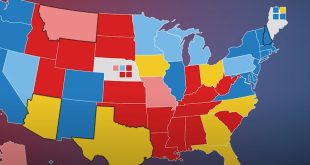The Agriculture Department said on Wednesday that it would establish a monitoring and data collection network to measure greenhouse gas emissions and determine how much carbon can be captured using certain farming practices.
The network, using $300 million in funding from the Inflation Reduction Act, will help quantify the outcomes of so-called climate-smart or regenerative agricultural practices, a cornerstone of the department’s approach to addressing a warming planet. The research and data that is collected will also be crucial to measuring progress on President Biden’s goal of halving greenhouse emissions by the end of the decade.
“It’s not just simply about promoting climate-smart agriculture, not simply about promoting proper science,” Tom Vilsack, the agriculture secretary, said in a news conference on Tuesday ahead of the announcement. “It’s also about expanding income sources for small and mid-size producers.”
The Inflation Reduction Act, an expansive climate, tax and health measure Mr. Biden signed into law last year, provided some $20 billion to shore up existing agricultural conservation programs that encouraged practices like sowing cover crops and not tilling the land. The department has also provided billions in additional funding to farming projects that reduce emissions, in part by capturing carbon dioxide, one of the main greenhouse gases, from the atmosphere and storing it as carbon in the soil.
But skeptics have warned that the efficacy of these farming methods in mitigating climate change is unproven. Researchers have not determined, for example, just how much carbon can be stored in the soil and for how long.
The $300 million investment seeks to address the scientific uncertainty around these practices. It will establish a network to examine how carbon is captured from soil across the country, create another focused on greenhouse gas emissions, and improve models to better measure agricultural conservation programs.
Building the networks will occur over the next eight years, and the Agriculture Department will make the data public a year after collection, a spokesman said.
Scott Faber, senior vice president for government affairs at the Environmental Working Group, a nonprofit advocacy organization, welcomed the move, calling the investment “a really important foundation that we should have laid 20 years ago.”
“We’re making terrible use of the tens of billions of conservation dollars that we are spending because we simply don’t know enough about which practices reduce emissions,” he added. “That is a gigantic, existential, putting-the-planet-at-risk problem that the U.S.D.A. is beginning to address.”
Currently, the agricultural sector is responsible for about 10 percent of emissions nationwide, according to government data. But the existing data collection systems contain gaps, can be out of date, or do not provide granular details on individual farming practices, said William Hohenstein, director of the Agriculture Department’s office of energy and environmental policy.
The announcement comes as some Republican lawmakers are seeking to rescind the $20 billion in funding from the Inflation Reduction Act dedicated to agricultural conservation.
Mr. Vilsack warned that rolling back such funding would be a “major mistake” because the ensuing initiatives, like the data collection networks, could encourage investment or growth in certain agricultural practices. More accurate measurements of their effects could lead to more market opportunities for farmers from the government and private sector alike, he said. Those could take the form of higher prices for carbon credits or conservation easements, for example.
“We’re going to collect a substantial amount of information, which in turn is going to allow us in a uniform way to reinforce the credibility of the information being provided, which in turn creates greater confidence, which in turn allows markets to develop, in turn results in greater adoption and income opportunities for farmers, ranchers and producers, all of which also helps to create jobs in rural places,” Mr. Vilsack said.
 Top Naija News: Nigerian News, Breaking News Nigeria and World News Top Naija News is a daily news publication in Nigeria, delivering the latest breaking news in Nigeria and around the world.
Top Naija News: Nigerian News, Breaking News Nigeria and World News Top Naija News is a daily news publication in Nigeria, delivering the latest breaking news in Nigeria and around the world.



